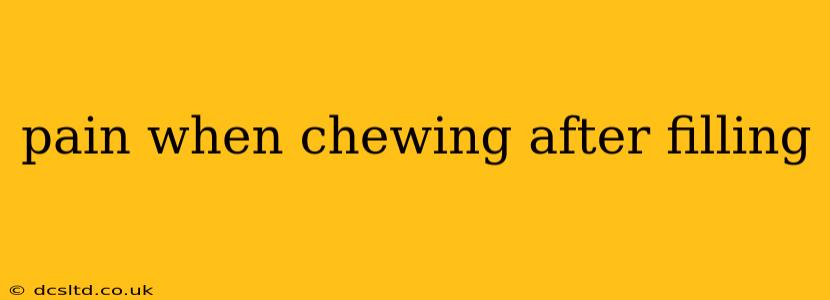Experiencing pain when chewing after getting a filling is a common concern, and it can be quite frustrating. While sometimes it's a minor issue that resolves quickly, other times it signals a more significant problem that requires professional attention. This comprehensive guide explores the potential causes of post-filling chewing pain, effective treatments, and preventative measures to help you understand and address this issue.
What Causes Pain When Chewing After a Filling?
Several factors can contribute to pain when chewing after a dental filling. Understanding the underlying cause is crucial for effective treatment.
-
Irritation of the tooth: The filling procedure itself can cause temporary irritation to the tooth's nerve and surrounding tissues. This often subsides within a few days. The process of drilling and placing the filling can also cause microscopic fractures in the tooth, which could also contribute to pain when chewing.
-
High filling: If the filling is placed too high, it can interfere with your bite, leading to discomfort and pain when chewing. This is often felt as a pressure or a sharp pain on the affected tooth.
-
Infection: In some cases, pain after a filling can be a sign of an infection. This could be due to bacteria entering the tooth during the procedure or a pre-existing infection that wasn't fully addressed. Signs of infection may include swelling, redness, and persistent, throbbing pain.
-
Fractured tooth: Sometimes, the filling process might reveal a pre-existing crack or fracture in the tooth that wasn't noticeable before. This can cause sharp pain, particularly when chewing.
-
Sinus infection: Pain in upper molars could sometimes be referred pain from a sinus infection. This type of pain is usually not directly related to the filling itself but can be mistaken for it. Other symptoms, like nasal congestion and headache, may help distinguish this cause.
-
Allergic reaction: Although rare, an allergic reaction to the filling material is possible. This might manifest as pain and inflammation in the area surrounding the filling.
How Long Does Post-Filling Pain Typically Last?
The duration of post-filling pain varies greatly depending on the underlying cause. Mild irritation usually subsides within a few days to a week. However, if the pain is severe, persistent, or accompanied by other symptoms like swelling or fever, it's crucial to seek professional dental care immediately.
How long should I wait before going back to the dentist?
If the pain is mild and gradually subsides within a few days, you can likely wait and monitor the situation. However, if the pain intensifies, persists for more than a week, or is accompanied by other symptoms, you should contact your dentist as soon as possible.
What Treatments Are Available for Post-Filling Pain?
Treatment for post-filling pain depends on the underlying cause.
-
Pain relievers: Over-the-counter pain relievers like ibuprofen or acetaminophen can help manage mild to moderate pain.
-
Adjusting the filling: If the filling is too high, your dentist can adjust it to restore proper bite alignment, resolving the pain.
-
Root canal: If the pain is caused by an infection or inflamed pulp (the soft tissue inside the tooth), a root canal may be necessary to remove the infection and save the tooth.
-
Extraction: In severe cases, such as a severely damaged or infected tooth, extraction might be the only option.
How Can I Prevent Pain After Getting a Filling?
While some pain is unavoidable, you can take steps to minimize the risk:
-
Choosing a reputable dentist: A skilled dentist will minimize trauma to the tooth during the procedure and use the appropriate techniques to ensure a well-placed filling.
-
Following post-procedure instructions: Adhering to your dentist's instructions regarding diet and oral hygiene is vital for proper healing and preventing complications.
-
Maintaining good oral hygiene: Regular brushing, flossing, and dental checkups can help prevent infections and other issues that may lead to pain after a filling.
-
Managing underlying dental problems: Addressing pre-existing issues such as cavities or gum disease can prevent complications during and after the filling procedure.
This information is for general knowledge and should not be considered medical advice. Always consult with your dentist for diagnosis and treatment of any dental pain or concerns. They can properly assess your specific situation and provide personalized recommendations.
